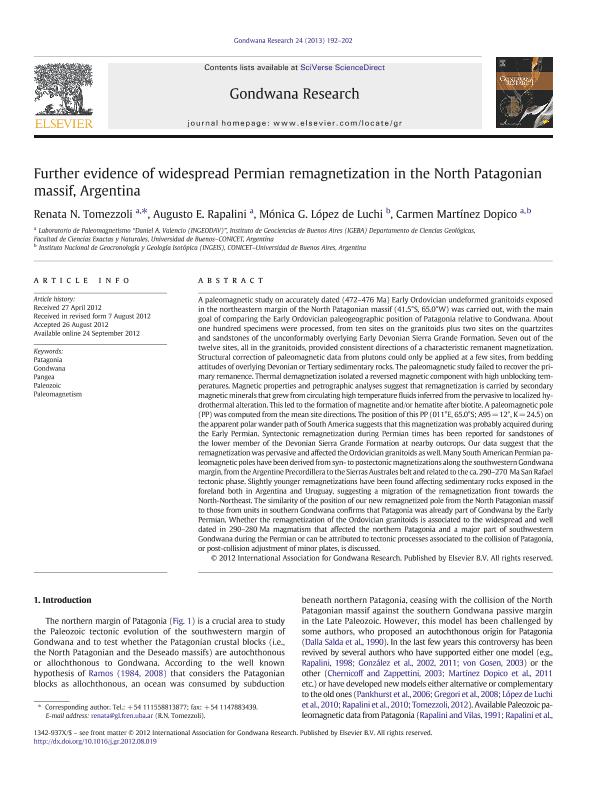Artículo
Further evidence of widespread Permian remagnetization in the North Patagonian massif, Argentina
Tomezzoli, Renata Nela ; Rapalini, Augusto Ernesto
; Rapalini, Augusto Ernesto ; Lopez, Monica Graciela
; Lopez, Monica Graciela ; Martínez Dopico, Carmen Irene
; Martínez Dopico, Carmen Irene
 ; Rapalini, Augusto Ernesto
; Rapalini, Augusto Ernesto ; Lopez, Monica Graciela
; Lopez, Monica Graciela ; Martínez Dopico, Carmen Irene
; Martínez Dopico, Carmen Irene
Fecha de publicación:
07/2013
Editorial:
Elsevier Science
Revista:
Gondwana Research
ISSN:
1342-937X
Idioma:
Inglés
Tipo de recurso:
Artículo publicado
Clasificación temática:
Resumen
A paleomagnetic study on accurately dated (472–476 Ma) Early Ordovician undeformed granitoids exposed in the northeastern margin of the North Patagonian massif (41.5°S, 65.0°W) was carried out, with the main goal of comparing the Early Ordovician paleogeographic position of Patagonia relative to Gondwana. About one hundred specimens were processed, from ten sites on the granitoids plus two sites on the quartzites and sandstones of the unconformably overlying Early Devonian Sierra Grande Formation. Seven out of the twelve sites, all in the granitoids, provided consistent directions of a characteristic remanent magnetization. Structural correction of paleomagnetic data from plutons could only be applied at a few sites, from bedding attitudes of overlying Devonian or Tertiary sedimentary rocks. The paleomagnetic study failed to recover the primary remanence. Thermal demagnetization isolated a reversed magnetic component with high unblocking temperatures. Magnetic properties and petrographic analyses suggest that remagnetization is carried by secondary magnetic minerals that grew from circulating high temperature fluids inferred from the pervasive to localized hydrothermal alteration. This led to the formation of magnetite and/or hematite after biotite. A paleomagnetic pole (PP) was computed from the mean site directions. The position of this PP (011°E, 65.0°S; A95 = 12°, K = 24.5) on the apparent polar wander path of South America suggests that this magnetization was probably acquired during the Early Permian. Syntectonic remagnetization during Permian times has been reported for sandstones of the lower member of the Devonian Sierra Grande Formation at nearby outcrops. Our data suggest that the remagnetization was pervasive and affected the Ordovician granitoids as well. Many South American Permian paleomagnetic poles have been derived from syn- to postectonic magnetizations along the southwestern Gondwana margin, from the Argentine Precordillera to the Sierras Australes belt and related to the ca. 290–270 Ma San Rafael tectonic phase. Slightly younger remagnetizations have been found affecting sedimentary rocks exposed in the foreland both in Argentina and Uruguay, suggesting a migration of the remagnetization front towards the North-Northeast. The similarity of the position of our new remagnetized pole from the North Patagonian massif to those from units in southern Gondwana confirms that Patagonia was already part of Gondwana by the Early Permian. Whether the remagnetization of the Ordovician granitoids is associated to the widespread and well dated in 290–280 Ma magmatism that affected the northern Patagonia and a major part of southwestern Gondwana during the Permian or can be attributed to tectonic processes associated to the collision of Patagonia, or post-collision adjustment of minor plates, is discussed.
Palabras clave:
Patagonia
,
Pangea
,
Gondwana
,
Paleozoic
Archivos asociados
Licencia
Identificadores
Colecciones
Articulos(IGEBA)
Articulos de INSTITUTO DE GEOCIENCIAS BASICAS, APLICADAS Y AMBIENTALES DE BS. AS
Articulos de INSTITUTO DE GEOCIENCIAS BASICAS, APLICADAS Y AMBIENTALES DE BS. AS
Articulos(INGEIS)
Articulos de INST.DE GEOCRONOLOGIA Y GEOLOGIA ISOTOPICA (I)
Articulos de INST.DE GEOCRONOLOGIA Y GEOLOGIA ISOTOPICA (I)
Citación
Tomezzoli, Renata Nela; Rapalini, Augusto Ernesto; Lopez, Monica Graciela; Martínez Dopico, Carmen Irene; Further evidence of widespread Permian remagnetization in the North Patagonian massif, Argentina; Elsevier Science; Gondwana Research; 24; 1; 7-2013; 192-202
Compartir
Altmétricas



